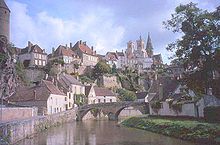The Three Musketeers (1961 film)
This article's tone or style may not reflect the encyclopedic tone used on Wikipedia. (August 2014) |
| The Three Musketeers | |
|---|---|
 Semur-en-Auxois, one of the locations | |
| Directed by | Bernard Borderie |
| Written by | Bernard Borderie et Jean-Bernard Luc [1] |
| Based on | The Three Musketeers by Alexandre Dumas père |
| Produced by | Films Borderie Les Films Modernes Le Film d'Art Fono Roma |
| Starring | Gérard Barray Mylène Demongeot Perrette Pradier Georges Descrières |
| Cinematography | Armand Thirard |
| Edited by | Christian Gaudin |
| Music by | Paul Misraki |
| Distributed by | Pathé Distribution |
Release date |
|
Running time | 186 minutes |
| Countries | France Italy |
| Language | French |
| Box office | $33.5 million[2] |
The Three Musketeers is a 1961 film adaptation of the 1844 novel by Alexandre Dumas, père which consists of two parts.[3] The script keeps close to the classic French novel. The director treats all the classic characters with respect, not making fun of any of them, although there is humour when d'Artagnan rides his peculiar horse and when Planchet supplies wine for the heroes.
The film's location shots were made in Bois de Boulogne, around and in the Château de Guermantes in Seine-et-Marne and in Semur-en-Auxois (department Côte-d'Or).
The settings, costumes and props are very elaborate and give the impression of historical accuracy.[4] Bernard Borderie and his crew demonstrated here already the qualities which later contributed substantially to the success of his series of five costume drama films about Anne Golon's heroine Angelique. Since Bernard Borderie had already made several Lemmy Caution films he was an expert for fighting scenes. In comparison to the likewise brilliant fencing the dancer Gene Kelly (An American in Paris, Xanadu) had provided as “d'Artagnan” in an earlier adaptation, the fencing in this film looks less like dancing and more dangerous. But Borderie also knew how to present a fist fight. When d'Artagnan defends Mme Bonacieux against a couple of the cardinal's thugs, the director does not only use dramatic sound effects but furthermore lets Barray's punches look more explosive by taking out frames very precisely when he is about to hit. He is also capable of making us believe an outnumbered man could really win the day if only certain circumstances are given, because in Borderie's films the thugs are often so overly keen on decking the hero that they actually hinder each other to succeed.
Cast
- Gérard Barray as d'Artagnan
- Mylène Demongeot as Milady de Winter
- Perrette Pradier as Constance Bonacieux
- Georges Descrières as Athos
- Bernard Woringer as Porthos
- Jacques Toja as Aramis
- Jean Carmet as Planchet
- Guy Delorme as the Count De Rochefort
- Daniel Sorano as Cardinal Richelieu
- Françoise Christoph as ( Queen) Anne of Austria
- Robert Berri as M. Bonacieux
- Henri Nassiet as M. de Tréville
- Guy Tréjan as (King) Louis XIII
- Jacques Berthier as the Duke of Buckingham
Reception
The film was the sixth most popular movie at the French box office in 1961.[2]
External links
References
- ^ "The Queens's Diamonds/The Revenge of Milady (screen writer's homepage)". Retrieved 2011-06-16.
- ^ a b French box office for 1961 at Box Office Story
- ^ "Les Trois Mousquetaires (2 époques) (Bernard Borderie, 1961): on ne présente plus l'œuvre d'Alexandre Dumas, ici adaptée en deux films". Retrieved 2011-06-16.
- ^ "A fine supporting cast,historically accurate costumes and beautiful scenery". Retrieved 2011-06-16.
- 1961 films
- French films
- French adventure films
- Italian films
- Italian adventure films
- French-language films
- Films directed by Bernard Borderie
- Films based on The Three Musketeers
- Films shot in France
- 1960s adventure films
- Swashbuckler films
- Films set in the 1620s
- Films set in France
- Films set in Paris
- Films released in separate parts
- Cultural depictions of Cardinal Richelieu
- Cultural depictions of Louis XIII
